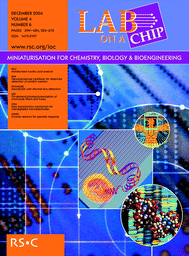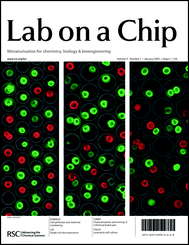Lab on a Chip – 10 years and flowing strong
It is ten years since the launch of Lab on a Chip and by any measure the journal has been a great success. The launch of Lab on a Chip helped focus and develop a burgeoning science and coalescing community to showcase what was possible with chip-based micro and nanofluidic technologies in a new and innovative forum. Despite the fact that, in retrospect, the journal seemed to be an instant success, for the first two years submissions averaged at four per month and we had thin issues. The first Impact Factor was just under 3.5 and since that time we have not looked back as we have overtaken established competitors both in terms of content and Impact Factor.No longer is the field just about miniaturising analytical devices, processes and detection systems, today we are growing cells, tissues and ‘organs’ (e.g., liver on a chip, body on a chip), sequencing genes, removing virus particles and bacteria from blood, isolating single molecules, treating single cells with drugs to look at metabolites, engineering new materials and imaging/detection systems, producing microbial fuel cells, elucidating neural and other biological processes, working on low-cost devices on paper, reducing the need for animal testing as well as a host of other potential applications in a huge number of areas.
At this point in time it seemed a good opportunity not only to look back, but more importantly to look forward to the future and how we could continue to engage with the community and contribute to discussions and debate that would improve the journal and potentially move the field forward. Therefore, as Lab on a Chip was moving into its 10th year of publication (and 10th birthday in 2011) we held a strategic meeting of the Editorial Board with guests invited from academia and industry to discuss their views on significant issues that face the community today, including commercialisation and the “killer application”, bottlenecks and the overlap of micro and nanofluidic research with related technologies.
A series of conclusions and actions resulted from this meeting which will have an impact on the journal and an Editorial from Professor Whitesides and a report produced by Professor Rustem Ismagilov will appear in forthcoming issues of Lab on a Chip. However, one conclusion was that the journal should include work from adjacent areas of research and technology.
Although Lab on a Chip authorship is truly international, there have been (and are) some “hot spots” and these countries have made significant contributions to the growth of the field and to the strength and quality of Lab on a Chip. With this in mind we decided to celebrate our 10th year of publication by commissioning a series of special issues that showcase content from these pioneering countries. In addition to covering the traditional Lab on a Chip subjects, we agreed to also cover adjacent areas of research and technologies as described above. Therefore, we suggested to contributors that they need not focus entirely on micro and nanofluidics, Lab on a Chip is very interested to showcase adjacent technologies that are likely to have an impact on the Lab on a Chip community so papers on materials, surface science, membrane science, energy, imaging, single cells, tissue engineering; clinical devices; (bio)MEMS; physics; electronics, and others are all welcome. However, all such papers must be related to or include lab on a chip technologies. They should discuss how their research relates to and advances micro and nanofluidics and describe their potential for, and relevance to, the various miniaturisation communities.
Therefore, it gives me great pleasure to introduce this first of the 10th Anniversary Issues focusing on Switzerland. This issue includes work that you may not normally associate with Lab on a Chip, but in future will be covered as part of the scope as an attempt to stimulate greater awareness of potential application areas, encourage discussion and generate ideas for additional research that may possibly lead to/encourage commercialisation of lab on a chip products.
Harp Minhas
Editor
| This journal is © The Royal Society of Chemistry 2010 |



